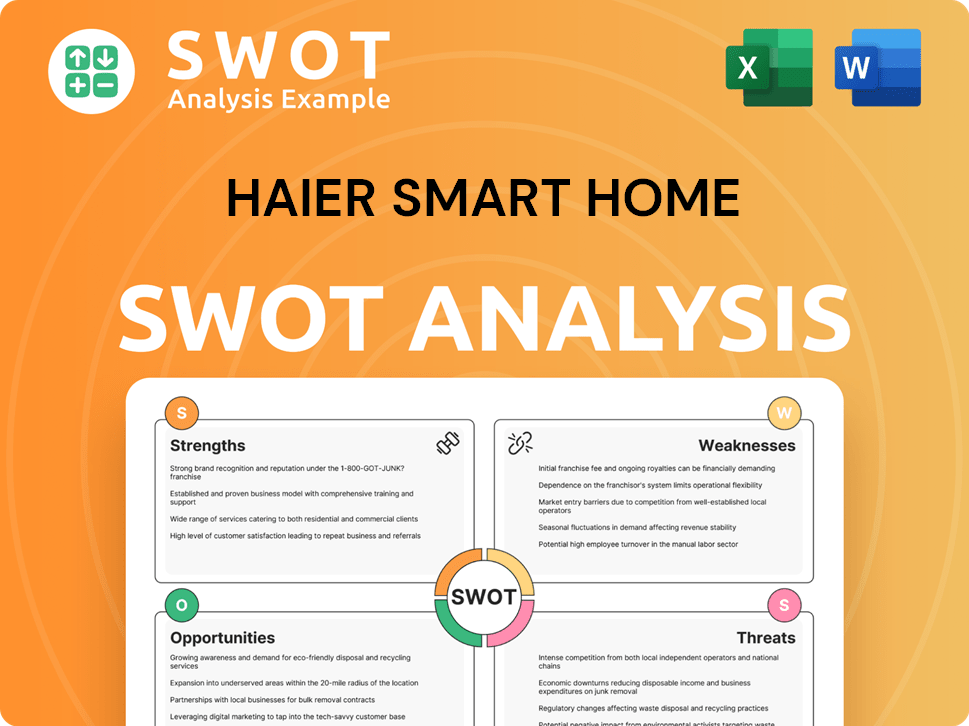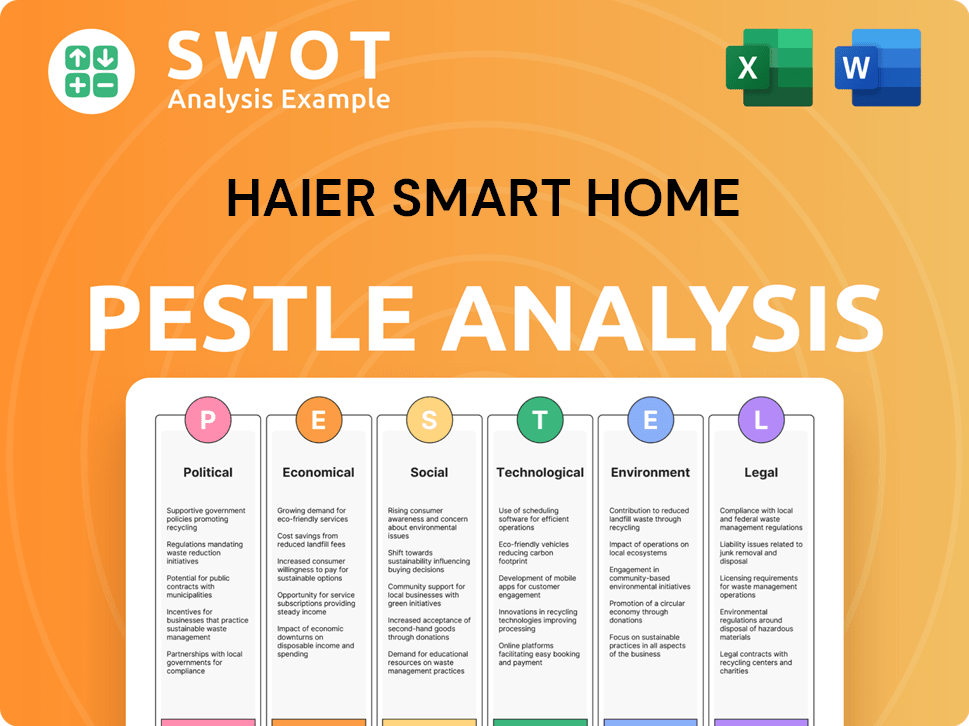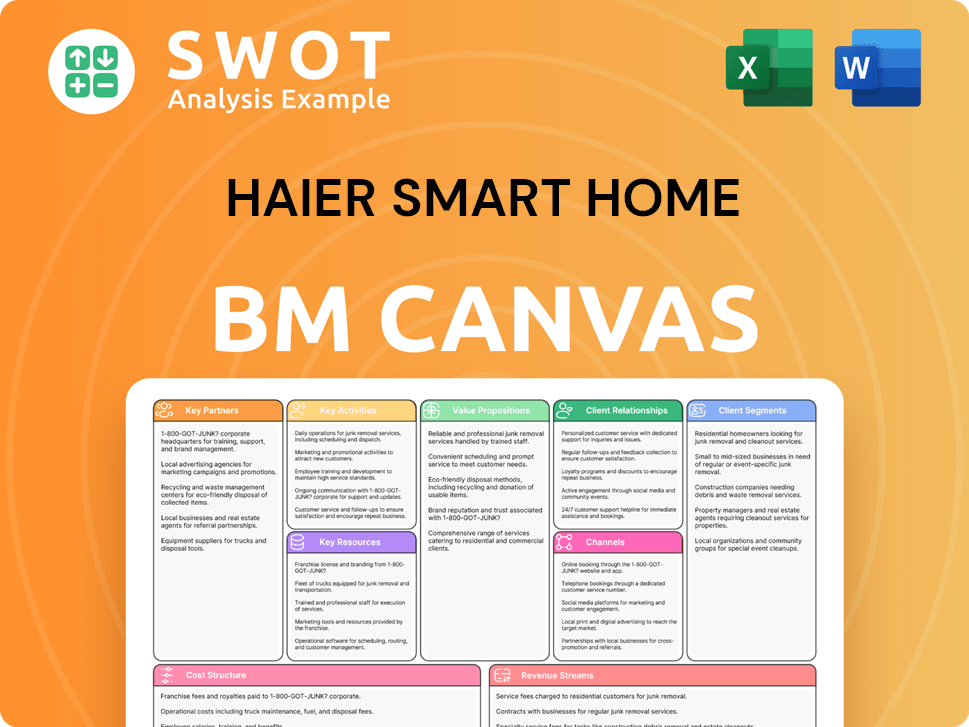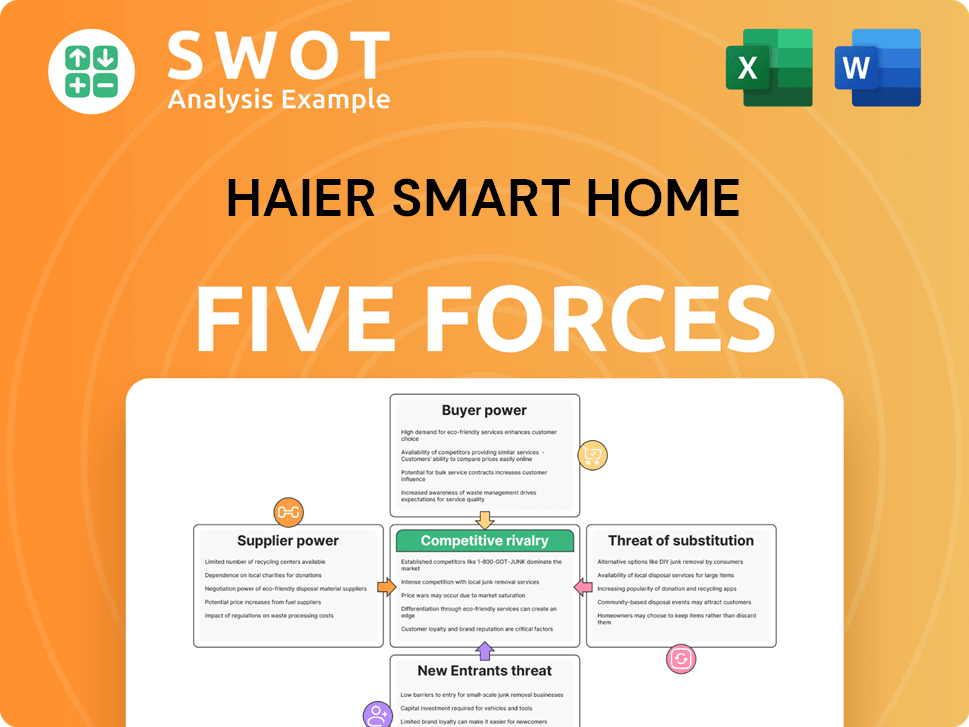Haier Smart Home Bundle
Who Really Owns Haier Smart Home?
Unraveling the ownership structure of a global giant like Haier Smart Home is key to understanding its trajectory. From its humble beginnings as Qingdao Refrigerator Factory in 1984, Haier has transformed into a world leader in smart home solutions. Knowing the key stakeholders and their influence is crucial for anyone looking to understand this innovative company.

The Haier Smart Home SWOT Analysis reveals how its ownership structure has shaped its strategic direction. This deep dive into Haier's ownership, from its roots to its current state, is essential for investors, analysts, and anyone interested in the inner workings of the Haier company. Understanding "Who owns Haier" provides critical insights into its future, its market strategies, and its overall performance. The Haier Group's influence and the roles of key stakeholders are vital to grasp.
Who Founded Haier Smart Home?
The story of Haier Smart Home, a global leader in home appliances and smart home solutions, begins with the Qingdao Refrigerator Factory in 1984. The transformation of this struggling factory into a global powerhouse is largely credited to Zhang Ruimin, who was appointed as its director. His leadership and vision were pivotal in shaping the company's future.
Unlike many companies that start with founders and initial equity distributions, Haier's early structure was rooted in the state-owned enterprise model prevalent in China at the time. This meant that the local government held the primary ownership, providing capital and resources to the factory.
Therefore, the early 'ownership' was essentially vested in the state, with the government exercising control. There were no individual founders with specific equity stakes at the outset. The focus was on improving product quality and management under Zhang Ruimin's direction, rather than on private equity distribution.
The Qingdao Refrigerator Factory was the starting point for Haier's journey.
Zhang Ruimin's leadership was key to transforming the factory.
Early ownership was primarily vested in the state.
There were no individual founders with specific equity percentages.
The initial phase focused on improving product quality and management.
The parent company of Haier Smart Home.
Understanding the early ownership structure of Haier Smart Home is crucial for grasping its evolution. The company's roots in a state-owned enterprise significantly shaped its initial trajectory. Today, Haier Smart Home is a publicly traded company, with a complex ownership structure. The company's headquarters are located in Qingdao, China. For more on the company's strategic growth, consider reading about the Growth Strategy of Haier Smart Home.
- Haier Smart Home, a key player in the global appliance market, has a significant presence in China and worldwide.
- The initial capital and resources came from the local government.
- The focus was on improving product quality and management under Zhang Ruimin's leadership.
- The company's transformation from a struggling factory to a global brand is a testament to its strategic vision.
Haier Smart Home SWOT Analysis
- Complete SWOT Breakdown
- Fully Customizable
- Editable in Excel & Word
- Professional Formatting
- Investor-Ready Format

How Has Haier Smart Home’s Ownership Changed Over Time?
The evolution of Haier Smart Home's ownership reflects its transformation from a state-owned enterprise to a publicly traded entity. A critical step was its initial public offering on the Shanghai Stock Exchange in 1993. This was followed by listings on the Hong Kong Stock Exchange in 2018 (6690.HK) and the Frankfurt Stock Exchange (D-share) also in 2018. These listings broadened the shareholder base, attracting institutional and individual investors. The company's journey showcases a strategic shift towards greater market participation and global investor interest.
The company's structure has been shaped by key events, including its initial public offerings and subsequent listings. These moves have not only diversified the ownership but also increased the company's visibility and access to capital markets. The strategic decisions have played a crucial role in its growth and expansion, particularly in the smart home and appliance sectors. The evolution of its ownership structure has been a key factor in its ability to adapt to changing market dynamics and global competition. The company's ability to attract investment and expand its operations has been significantly influenced by these strategic shifts.
| Event | Date | Impact on Ownership |
|---|---|---|
| Shanghai Stock Exchange Listing | 1993 | Initial public offering, broadened shareholder base. |
| Hong Kong Stock Exchange Listing | 2018 | Further expanded investor base, increased international exposure. |
| Frankfurt Stock Exchange (D-share) Listing | 2018 | Enhanced access to European capital markets. |
As of late 2024 and early 2025, the major stakeholders in Haier Smart Home include a mix of state-owned entities, institutional investors, and public shareholders. Haier Group Corporation, a state-owned collective enterprise, remains a significant shareholder, reflecting the company's origins. Institutional investors, including large asset management firms and mutual funds, hold substantial stakes through its various listings. The company's financial reports indicate continued strong interest from international investors, drawn by its global market leadership and smart home ecosystem development. This has led to increased scrutiny and demands for transparency, influencing corporate governance and strategic decision-making.
Haier Smart Home's ownership structure is a blend of state-backed and public shareholders.
- Haier Group Corporation is a significant shareholder.
- Institutional investors hold substantial stakes.
- Public listings have expanded the investor base.
- The company's structure reflects its growth and global expansion.
Haier Smart Home PESTLE Analysis
- Covers All 6 PESTLE Categories
- No Research Needed – Save Hours of Work
- Built by Experts, Trusted by Consultants
- Instant Download, Ready to Use
- 100% Editable, Fully Customizable

Who Sits on Haier Smart Home’s Board?
The current Board of Directors of Haier Smart Home reflects a balance between representatives of major shareholders, management, and independent voices. As of early 2025, the board typically includes executive directors, non-executive directors, and independent non-executive directors. Individuals representing Haier Group Corporation, the largest shareholder, hold key positions on the board, ensuring alignment with the parent entity's strategic vision. Executive directors are usually senior management members, driving the company's operational and strategic initiatives. The composition of the board is designed to ensure a blend of strategic oversight and operational expertise, crucial for navigating the competitive landscape of the smart home and appliances market.
The board's structure aims to foster effective corporate governance, with independent directors playing a vital role in overseeing management and protecting shareholder interests. The presence of independent directors helps to ensure transparency and accountability in decision-making processes. The board's focus includes strategic planning, risk management, and ensuring compliance with regulatory requirements. The board's composition is regularly reviewed to maintain an appropriate balance of skills, experience, and independence, supporting the long-term success of Haier Smart Home.
| Board Role | Description | Key Responsibilities |
|---|---|---|
| Executive Directors | Senior management members | Driving operational and strategic initiatives |
| Non-Executive Directors | Represent major shareholders | Ensuring alignment with the parent entity's vision |
| Independent Non-Executive Directors | Independent voices | Overseeing management and protecting shareholder interests |
Haier Smart Home generally operates on a one-share-one-vote principle for its publicly traded shares. However, the significant stake held by Haier Group Corporation grants it substantial voting power and influence over major corporate decisions. There are no publicly reported instances of dual-class shares or golden shares that would grant disproportionate voting rights to specific individuals or entities beyond their equity holdings. The presence of a diverse shareholder base encourages robust corporate governance practices and increased accountability, influencing decisions related to environmental, social, and governance (ESG) factors and capital allocation. As of 2024, Haier Group holds a significant percentage of shares, which is key to understanding Haier ownership and its influence on the company.
Understanding the voting structure of Haier Smart Home is crucial for investors and stakeholders. The company operates under a one-share-one-vote system for its publicly traded shares. However, the substantial stake held by Haier Group Corporation gives it significant influence.
- Haier Group Corporation's significant ownership grants it substantial voting power.
- The company's governance structure promotes accountability and transparency.
- The presence of institutional investors encourages robust corporate governance.
- The board's composition is designed to ensure a blend of strategic oversight and operational expertise.
Haier Smart Home Business Model Canvas
- Complete 9-Block Business Model Canvas
- Effortlessly Communicate Your Business Strategy
- Investor-Ready BMC Format
- 100% Editable and Customizable
- Clear and Structured Layout

What Recent Changes Have Shaped Haier Smart Home’s Ownership Landscape?
Over the past few years (2022-2025), the ownership landscape of Haier Smart Home has evolved, reflecting wider trends in the technology and consumer durables sectors. The company has seen increased investment from institutional investors, particularly those focused on the smart home and IoT industries. This is indicated by the financial disclosures from 2024. While there haven't been major public share buybacks or offerings that significantly altered the ownership structure, routine market activities continue.
Leadership changes, although not directly affecting ownership percentages, can influence investor confidence. The company has focused on global expansion, including mergers and acquisitions of brands like Candy and GE Appliances in earlier years. This expansion of its asset base can attract new investors. Founder dilution is a natural trend for mature public companies as they raise capital and grow their shareholder base. The rise in institutional and passive investor ownership is a key trend in the smart home industry, which Haier Smart Home is a part of. The company remains committed to enhancing shareholder value through innovation and global expansion.
The Marketing Strategy of Haier Smart Home has played a role in shaping its ownership appeal. The shift towards institutional and passive investor ownership reflects the growing maturity of the smart home market. Key stakeholders are watching the company's performance and global expansion strategies closely. Haier Smart Home's commitment to innovation and shareholder value is likely to continue influencing its ownership profile.
Increased institutional investment in Haier Smart Home. Focus on technology and consumer durables funds. No major share buybacks or secondary offerings that shifted ownership significantly.
Leadership changes indirectly influence investor confidence. Strategic mergers and acquisitions expand the asset base. Founder dilution is a natural process in a growing company.
Consolidation and institutional investment are increasing. Haier Smart Home is part of these industry trends. Commitment to innovation and global expansion continues.
Market performance and growth strategies. The company's global expansion plans. Ongoing commitment to shareholder value.
Haier Smart Home Porter's Five Forces Analysis
- Covers All 5 Competitive Forces in Detail
- Structured for Consultants, Students, and Founders
- 100% Editable in Microsoft Word & Excel
- Instant Digital Download – Use Immediately
- Compatible with Mac & PC – Fully Unlocked

Related Blogs
- What are Mission Vision & Core Values of Haier Smart Home Company?
- What is Competitive Landscape of Haier Smart Home Company?
- What is Growth Strategy and Future Prospects of Haier Smart Home Company?
- How Does Haier Smart Home Company Work?
- What is Sales and Marketing Strategy of Haier Smart Home Company?
- What is Brief History of Haier Smart Home Company?
- What is Customer Demographics and Target Market of Haier Smart Home Company?
Disclaimer
All information, articles, and product details provided on this website are for general informational and educational purposes only. We do not claim any ownership over, nor do we intend to infringe upon, any trademarks, copyrights, logos, brand names, or other intellectual property mentioned or depicted on this site. Such intellectual property remains the property of its respective owners, and any references here are made solely for identification or informational purposes, without implying any affiliation, endorsement, or partnership.
We make no representations or warranties, express or implied, regarding the accuracy, completeness, or suitability of any content or products presented. Nothing on this website should be construed as legal, tax, investment, financial, medical, or other professional advice. In addition, no part of this site—including articles or product references—constitutes a solicitation, recommendation, endorsement, advertisement, or offer to buy or sell any securities, franchises, or other financial instruments, particularly in jurisdictions where such activity would be unlawful.
All content is of a general nature and may not address the specific circumstances of any individual or entity. It is not a substitute for professional advice or services. Any actions you take based on the information provided here are strictly at your own risk. You accept full responsibility for any decisions or outcomes arising from your use of this website and agree to release us from any liability in connection with your use of, or reliance upon, the content or products found herein.